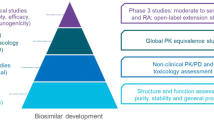ABSTRACT
Purpose
To develop and evaluate methods for conducting adaptive population pharmacokinetic bridging studies.
Methods
An adaptive D-optimal design based on optimization of the population Fisher information matrix was used to determine the best sampling schedule for a target-population. Recruitment of the target-population was divided into batches and patients are assumed to enrol by batch. A prior-population model was used to determine the optimal sampling schedule for the first batch and to stabilise the data analysis in the interim iteration. Simulation studies were performed under two scenarios (1) the prior- and target-populations have similar pharmacokinetic profiles and (2) the pharmacokinetic profiles diverge significantly. A design criterion to determine early full enrolment was also proposed.
Results
The target-population estimates obtained using the proposed method were compared to estimates obtained if the target-population was studied with a design optimized based on the prior-population model. The proposed method is shown to be not inferior in scenario (1) and superior in scenario (2). The criterion to determine early full enrolment was proven to be effective.
Conclusions
An adaptive optimal design method together with an early full enrolment criterion were evaluated and resulted in more accurate estimates for the target-population in bridging studies.







Similar content being viewed by others
REFERENCES
ICH. International Conference on Harmonisation Tripartite Guidance E 5 1997; Ethnic Factors in the Acceptability of Foreign Data, The U.S. Federal Register, Washington, D.C., 1998; Vol. 83, 31790–31796.
Liu J-P, Chow S-C. Bridging studies in clinical developmant. J Biopharm Stat. 2002;12:359–67.
Retout S, Duffull S, Mentré F. Development and implementation of the population Fisher information matrix for the evaluation of population pharmacokinetic designs. Comput Meth Programs Biomed. 2001;65:141–51.
Gueorguieva I, Aarons L, Jorga K, Rodgers T, Rowland M. Optimal design for multivariate response pharmacokinetic models. J Pharmacokinet Pharmacodyn. 2006;33:97–124.
Waterhouse TH, Redmann S, Duffull S, Eccleston JA. Optimal design for model discrimination and parameter estimation for itraconazole population pharmacokinetics in cystic fibroses patients. J Pharmacokinet Pharmacodyn. 2005;32:97–124.
Foo L-K, Duffull S. Methods of robust design of nonlinear models with an application to pharmacokinetics. J Biopharm Stat. 2010;20:886–902.
D’Argenio DZ. Incorporating prior parameter uncertainty in the design of sampling schedules for pharmacokinetic parameter estimation experiments. Math Biosci. 1990;99:105–18.
Dodds MG, Hooker AC, Vicini P. Robust population pharmacokinetic experiment design. J Pharmacokinet Pharmacodyn. 2005;32:33–64.
Walterand E, Pronzato L. Optimal experiment design for nonlinear models subject to large prior uncertainties. Am J Physiol. 1987;253:R530–4.
O’Quigley J, Pepe M, Fisher L. Continual reassessment method: a practical design for phase 1 clinical trials in cancer. Biometrics. 1990;46:33–48.
Special issue on adaptive design in clinical research. J Biopharm Stat. 2005;15:4.
Bornkamp B, Bretz F, Dmitrienko A, Enas G, Gaydos B, Hsu CH, et al. Inovative approaches for designing and analysing adaptive dose-ranging trials. J Biopharm Stat. 2007;17:965–95.
Bandyopadhyay N, Dragalin V. Implementation of an adaptive group sequential design in a bioequivalence study. Pharm Stats. 2007;6:115–22.
Dragalin V, Hsuan F, Padmanabhan SK. Adaptive designs for dose-finding studies based on sigmoid Emax model. J Biopharm Stat. 2007;17:1051–70.
Maloney A, Schaddelee M, Friejer J, Krauwinkel W, Gelderen M, Jacqmin P, et al. An example of optimal phase II design for exposure response modelling. J Pharmacokinet Pharmacodyn. 2010;37:475–91.
Maloney A, Karlsson MO, Simonsson USH. Optimal adaptive design in clinical drug development: a simulation example. J Clin Pharmacol. 2007;47:1231–43.
POPT available at http://www.winpopt.com
Savic RM, Jonker DM, Kerbusch T, Karlsson MO. Implementation of a transit compartment model for describing drug absorption in pharmacokinetic studies. J Pharmacokinet Pharmacodyn. 2007;34:711–26.
ACKNOWLEDGMENTS & DISCLOSURES
Lee Kien Foo is supported by a University of Otago postgraduate scholarship. We acknowledge helpful discussions with James McGree and at the Population Optimal Design of Experiments meeting in Berlin 2010.
Author information
Authors and Affiliations
Corresponding author
Electronic supplementary material
Below is the link to the electronic supplementary material.
ESM 1
Supplement: Boxplots of percentage relative error (%RE) for the simulation-estimation study to evaluate the estimation capability of NONMEM for the transit compartment model. The study design is an intensive design with fifteen samples per patient. Structural parameters clearance (CL), volume of distribution (V), mean transit time (MTT) and number of transit compartments (N). Statistical parameters between subject variability (BSV) for CL \( \left( {\omega_{CL}^2} \right) \), V \( \left( {\omega_V^2} \right) \) and MTT \( \left( {\omega_{MTT}^2} \right) \). Residual unexplained variability variance of the proportional error \( \left( {\sigma_{{\varepsilon_p}}^2} \right) \) and additive error \( \left( {\sigma_{{\varepsilon_a}}^2} \right) \). The horizontal line within each subplot is the zero percentage. (JPEG 106 kb)
Rights and permissions
About this article
Cite this article
Foo, L.K., Duffull, S. Adaptive Optimal Design for Bridging Studies with an Application to Population Pharmacokinetic Studies. Pharm Res 29, 1530–1543 (2012). https://doi.org/10.1007/s11095-011-0659-3
Received:
Accepted:
Published:
Issue Date:
DOI: https://doi.org/10.1007/s11095-011-0659-3




